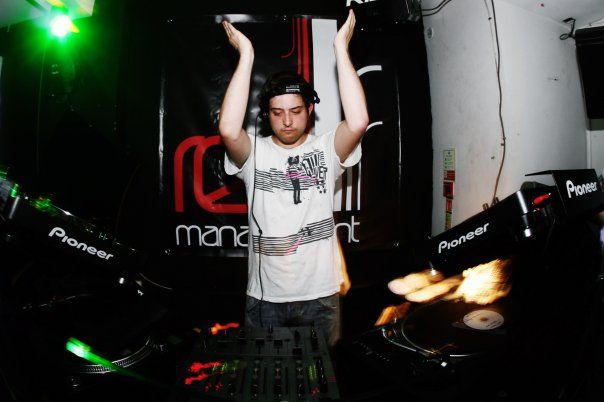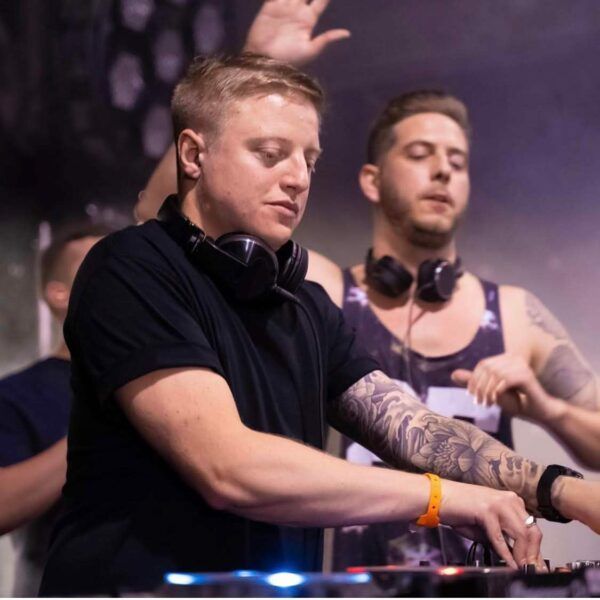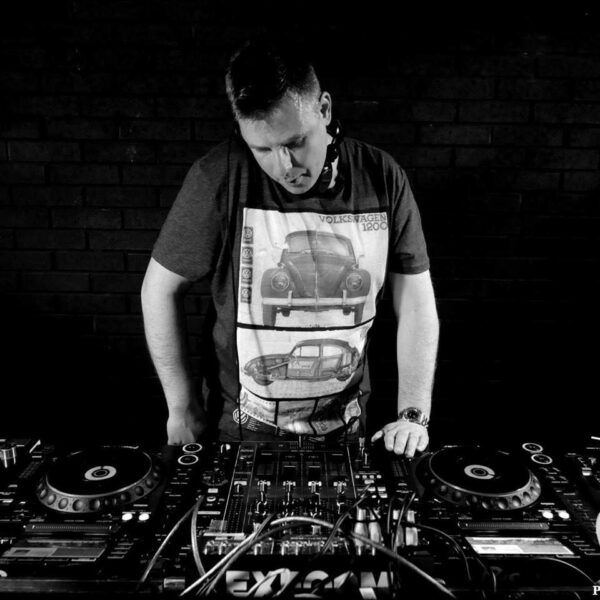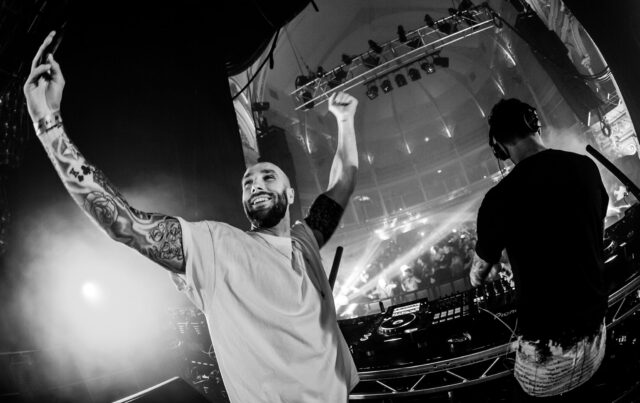Outlandish with colour and hedonism, Hard House as a genre rose to prominence in 1998 as it enjoyed almost a decade of bliss under the bright lights of the dance music skyline. Despite not experiencing the popular heights of its glory years, the legacy of the genre is still being written today by such respected authors like Tidy.
Founded 25 years ago by the Tidy Boys (a.k.a. Andy Pickles and Amadeus Mozart), the wheels on this nostalgic imprint started turning whilst this dynamic duo were hustling behind the scenes of Andy’s father’s DJ-only service, Music Factory, as studio production engineers.
Always adapting and evolving, the Tidy Boys remained undeterred by the pandemic’s global onslaught. Bridging the Hard House gap between the old guard and the next generation, this rare standstill caused by the coronavirus has enabled Andy and Ama to birth their own online learning platform: TidyPro.
Resurgent and resourceful, the Tidy crew has hosted online MasterClasses and courses – educating more than 600 aspiring producers on the many facets of music production including arrangement, composition, mix downs and more.
Now being discovered by a new wave of music enthusiasts, the Leeds-based imprint is sharing the gift of Hard House in more ways than just education. Truly encompassing the rebellious nature of what this genre is all about, Tidy has more than 350 releases to their name.
Championing everything from contemporary jackin’ house to the emotional roller-coaster of harder trance, Tidy is also playing a big role in the rise of newer, harder house. Fast gaining momentum via Untidy with contributions from the likes of Josh Butler, Sam Divine and Sam Townend, the wheels on the rediscovery of dance music’s Northern Soul are certainly in motion.
Delving deeper into the legendary 25-year history of Tidy’s Hard House discography and how they are engaging the next generation, we caught up with a selection of the genre’s finest production talent – Fireball Recordings beat-master Ben Stevens, hard-house innovator BK, Tidy’s former in-house producer Paul Maddox, and Untidy Trax head-honcho Sam Townend.
Ben Stevens: “My main aim is for more people to be making and playing hard house“

Tell us about yourself, your sound and your contribution in the Hard House scene.
I’ve been playing hard house for the past 19 years and over that time, I’ve managed to turn it into a job that I wouldn’t trade for the world. I work on quite a few of the behind the scenes aspects of the genre including record label management and running the Toolbox Digital download store. My first productions were in 2004, and since then I’ve gone on to produce around 300 or so tracks. I’m usually associated with the faster and harder end of the genre, but love all of the various styles that you would hear at a hard house event.
Let’s discuss ‘Take Me Back’, released in 2020. What is the story behind this record and what inspired your creative flow for this one?
We were putting together a new Tidy Trax compilation to be mixed by The Tidy Boys and I was asked to write something new for the project. I wanted to produce a track that had some uplifting elements and would give it a wide appeal to be played across the hard house spectrum. I took the inspiration for the track from some old 90’s trance tracks that I had been listening to and merged it with some slightly techy sounding drums and percussion.
For you, what is the stand-out element from this production and why? What makes this track so memorable?
The vocal sample, along with the main melody in it, really makes the track memorable for me and takes me back to memories of the dance floor.
Can you expand on your production process here? What software/hardware did you use within your creative flow?
I’ve been using Ableton Live for the past 10 years or so now after switching from Cubase. I found the workflow better and it was far faster to get the projects going and start getting results. Synth wise I’ve been loving Hive 2 from U-he recently along with some old favourites such as Massive from Native Instruments. The main melody in this track came from Hive layered with a super-saw from my Roland JP8000.
How well do you think the track has stood the test of time?
I would hope it will still be getting plays over the next few years, but as it’s only 6 months or so old it’s a difficult one to gauge. Sam Townend did a fantastic Untidy style remix of it that opened it up to other DJ’s and this also and a great response at it’s release.
How do you see your style of production influencing and engaging the next generation of Tidy fans?
My main aim is for more people to be making and playing hard house. Whether it’s house music that’s a bit harder at 130bpm or the faster style I’m more well known for, the more there is the better. I’m always happy to help or answer any questions people have about writing this style of music and if anything I have done influences people to get into the genre that is fantastic!
Paul Maddox: “Finding your own “right” way is the most important thing“

Tell us about yourself, your sound and your contribution in the Hard House scene…
I’m Paul Maddox, I was the in-house producer at Tidy in the early 00s and have been part of the Hard House scene since then really. Both with my own productions under various aliases, and as an engineer behind the scenes for several other artists.
Let’s discuss ‘Have Faith’, released in 2006. What is the story behind ‘Have Faith’? What inspired your creative flow for this one?
This one was actually the B-side to “In it for Kicks”, which was a bit more experimental relative to the Hardhouse sound of the time, so I decided to do something a bit more straight-up for the flip, which has gone on to become a bit of a fan favourite and has rarely left my set since!
For you, what is the stand-out element from this production and why? What makes this track so memorable?
The whole thing is built around the vocal sample, and is all set on a really bumping, swingy groove reminiscent of the stuff on Tripoli Trax in the late 90s. The arrangement has these extra 2-bar descending sections in it where the vocal hook drops into a lift in the bassline, then snaps straight back to the groove, which I think keeps the excitement building without the need for loads of breaks and drops.
Can you expand on your production process here – what software/hardware did you use within your creative flow?
This was written not long after I’d switched from using a mainly hardware setup in the Tidy studio, to a fully in-the-box setup in my space at home. I was using Cubase re-wired to Reason, as I loved the workflow (and Low CPU overhead) of the samplers in Reason compared to using Halion or Kontakt in Cubase. The NN19 , Dr Octorex and Scream distortion are all over this, and IIRC the main chords/stabs were from the Access Virus Powercore.
How do you see your style of production influencing and engaging the next generation of Tidy fans?
I’ve been doing quite a bit of tuition for the TidyPro platform, and really enjoy passing the knowledge I’ve accumulated over the past 20 years or so on to the next generation of producers. One thing that I always stress to the students though is that all I’m showing is the way I choose to do things – nothing is ever really right or wrong with any creative process, so finding your own “right” way is the most important thing.
BK: “Having an individual style and remembering hooks is everything“

Tell us about yourself, your sound and your contribution in the Hard House scene…
My Artist name is BK. I used to be part of Nukleuz records which was the largest selling independent label in the world for two years running. I have produced 100’s of Tracks including ‘Revolution’ and ‘Music is Moving’ under my Cortina alias. I have also worked closely with Tidy for many years.
Let’s discuss your remix of All Nighters’ ‘Black is Black’, released in 2000. We’re curious, what is the story behind your remix and what inspired your creative flow for this one?
This was my favourite Tidy production of all as I had the chance to remix one of my favourite records, ‘Black is Black’ by the All Nighters. I used to be a resident selector at a club called Trade, and this production was done specifically for that dance floor and was inspired by that underground after hours vibe.
For you, what is the stand-out element from this production and why? What makes this track so memorable?
There had been a few remixes done before but everyone else seemed to ignore the amazing riff in the track. For me I wanted to make it a feature again.
Can you expand on your production process here – what software/hardware did you use within your creative flow?
Back then I would have used an MPC 60 with outboard gear. My set-up consisted of the Virus synth, the Novation Super Nova, the Alpha jump as well as a rack of Akai samplers and Lexicon reverbs, a sound craft desk and a Drawmer compressor.
How well do you think the track has stood the test of time?
It’s still played today if you want to drop a classic, so I guess that’s pretty good after 21 years!
How do you see your style of production influencing and engaging the next generation of Tidy fans?
Hopefully drumming home the message of having an individual style and remembering hooks is everything.
Sam Townend: “The best tracks are the simplest ones in my opinion“

Tell us about yourself, your sound and your contribution in the Hard House scene…
My sound is optimised by the Untidy label, which is very much the Harder side of House music. Think big chunking energetic groovers sitting between 130 and 135 BPM. It’s feel good music for the dance floor, with a big sprinkling of soul. I’ve worked with Tidy as an artist and as part of the team (label manager & events manager) since 2007.
Let’s discuss ‘Holy Geezus’, released in 2021. What is the story behind ‘Holy Geezus’ and what inspired your creative flow for this one?
I wanted to make a track that harked back to the late 90’s era of Hard House and club music, but still sounded contemporary and brought in modern production elements. The best tracks are the simplest ones in my opinion, and this was how I approached making this record. It all stemmed from writing a good riff, finding a good vocal sample and the rest of the track just fell into the right place. Basically, repeating that hook throughout the record. It’s one of the simplest but most effective tracks I have written.
For you, what is the stand-out element from this production and why? What makes this track so memorable?
Again, it’s the simplicity of it. It’s literally a good riff, good groove and a great sample. It all stems down to sound choice and then arrangement. People get too carried away with trying to create musical masterpieces which is all well and good, but sometimes going back to basics is all you need to create a good club banger.
What distinct Tidy style would you say makes it instantly identifiable?
The fact that it combined such a feel good ‘party time’ riff with a recognisable stand out vocal sample; it fits the ethos of Tidy very well. The riff is an original written melody, but it’s been done so it feels like an old friend wrapping its arms around you; it feels familiar without being familiar and is definitely a party starter.
Can you expand on your production process here – what software/hardware did you use within your creative flow?
The track was written in Ableton using all software. The lead and bass sounds were created in Sylenth, which isn’t the most upfront or newest of synthesisers on the market, but I personally love the sounds that are made in it. The inspiration came from tracks I listened to before making this record, and were the biggest thing for me to get the creative flow and gave me an idea of the vibe I wanted to head down.
How do you see your style of production influencing and engaging the next generation of Tidy fans?
My sound has the DNA of classic Hard House but takes it in a more contemporary direction by trying new sounds, samples and ideas. The Untidy sound has really started to gain momentum in recent months and it’s great to see so many producers wanting to make this new harder house sound.
A golden youth euphoria awaits.
A genre constructed around a culture of socialising, dancing and having a damn good time, Tidy embodies everything that Hard House is and more – a true multi-genre genre reflection of working-class honesty and pride.
Longing to celebrate their impressive quarter-century feat with Tidy 25, ongoing COVID-19 restrictions means the wait for Hard House loyalists continues. However, as anticipation surrounding their infamous 3-day weekender in North Wales increases, the ignition of golden youth euphoria for many continues, and the next generation are already reaping the rewards.
Get to know Tidy here, and save the date for Tidy 25 – happening July 8-10, 2022.





